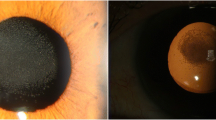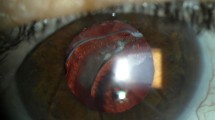Abstract
Purpose
To report clinicopathologic and ultrastructural feature of one opacified hydrophilic acrylic intraocular lens (IOL) explanted from a diabetic patient.
Methods
A 48-year-old man underwent trans pars plana vitrectomy and phacoemulsification with implantation of a hydrophilic acrylic lens OS in November 2008. The patient complained of a marked decrease in visual acuity in May 2009 as a result of a milky opalescence of the IOL. Intraocular lens explantation and exchange were performed in August 2009, and the explanted IOL was submitted to our center for detailed pathologic, histochemical and ultrastructural evaluation. It was stained by the von Kossa method for calcium, and also underwent scanning electron microscopy and energy dispersive radiograph spectroscopy to ascertain the nature of the deposits leading to opacification.
Results
Opacification of the IOL was found to be the cause of the decreased visual acuity. The opacification involved only the IOL optic, and the haptics was clear. Histochemical and ultrastructural analyses revealed that the opacity was caused by deposition of calcium and phosphate within the lens optic.
Conclusion
We believe this report of calcification of the Akreos® MI-60 IOL is of clinicopathological importance. Long-term follow-up of diabetic patients implanted with this IOL should be maintained by surgeons and manufacturers.






Similar content being viewed by others
References
Taylor HR. Cataract: how much surgery do we have to do? Br J Opthalmol. 2000;84:1–2.
Barrett GD, Constable IJ, Stewart AD. Clinical results of hydrogel lens implantation. J Cataract Refract Surg. 1986;12:623–31.
Chehade M, Elder MJ. Intraocular lens materials and styles: a review. Aust NZ J Ophthalmol. 1997;25:255–63.
Apple DJ, Werner L. Complications of cataract and refractive surgery: a clinicopathological documentation. Trans Am Ophthalmol Soc. 2001;99:95–107. discussion 107–109.
Dick HB, Tehrani M, Brauweiler P, Haefliger E, Neuhann T, Scharrer A. Complications of foldable intraocular lenses requiring explantation. Results of the 2000 and 2001 survey in Germany. Ophthalmolge. 2003;100:465–70.
Fernando GT, Crayford BB. Visually significant calcification of hydrogel intraocular lenses necessitating explantation. Clin Exp Ophthalmol. 2000;28:280–6.
Mamalis N. Complications of foldable intraocular lenses requiring explantation or secondary intervention: 2001 survey update. J Cataract Refract Surg. 2002;28:2193–201.
Mamalis N, Davis B, Nilson CD, Hickman MS, Leboyer RM. Complications of foldable intraocular lenses requiring explantation or secondary intervention: 2003 survey update. J Cataract Refract Surg. 2004;30:2209–18.
Neuhann IM, Werner L, Izak AM, Pandey SK, Kleinmann G, Mamalis N, Neuhann TF, Apple DJ. Late postoperative opacification of a hydrophilic acrylic (hydrogel) intraocular lens: a clinicopathological analysis of 106 explants. Ophthalmology. 2004;111:2094–101.
Georgopoulos M, Menapace R, Findl O, Petternel V, Kiss B, Rainer G. After-cataract in adults with primary posterior capsulorhexis: comparison of hydrogel and silicone intraocular lenses with round edges after 2 years. J Cataract Refract Surg. 2003;29:955–60.
Werner L, Apple DJ, Escobar-Gomez M, ÖhrstrÖm A, Crayford BB, Bianchi R, Pandey SK. Postoperative deposition of calcium on the surfaces of a hydrogel intraocular lens. Ophthalmology. 2000;107:2179–85.
Werner L, Apple DJ, Escobar-Gomez M, Pandey SK. Deposits on the optical surfaces of Hydroview intraocular lenses; a clinicopathological analysis of 9 explanted lenses. J Cataract Refract Surg. 2001;27:1485–92.
Rauz S, Stavrou P, Murray PI. Evaluation of foldable intraocular lenses in patients with uveitis. Ophthalmology. 2000;107:909–19.
Abela-Formanek C, Amon M, Schauersberger J, Kruger A, Nepp J, Schild G. Results of hydrophilic acrylic, hydrophobic acrylic, and silicone intraocular lenses in uveitic eyes with cataract; comparison to a control group. J Cataract Refract Surg. 2002;28:1141–52.
Mandić Z, Petric I, Bencić G, Vatavuk Z, Bojić L. Postoperative outcomes after implantation of intraocular lenses in eyes with cataract and uveitis. Coll Antropol. 2005;29:9–12.
Pandey SK, Werner L, Apple DJ, Kaskaloglu M. Hydrophilic acrylic intraocular lens optic and haptics opacification in a diabetic patient: bilateral case report and clinicopathologic correlation. Ophthalmology. 2002;109:2042–51.
Yu AK, Kwan KY, Chan DH, Fong DY. Clinical features of 46 eyes with calcified hydrogel intraocular lenses. J Cataract Refract Surg. 2001;27:1596–606.
Olson RJ. New cases of crystalline deposits on intraocular lenses not related to any specific viscoelastic. Arch Ophthalmol. 1994;112:1037–42.
Izak AM, Werner L, Pandey SK, Apple DJ. Calcification of modern foldable hydrogel intraocular lens designs. Eye. 2003;17:393–406.
Mak ST, Wong AC, Tsui WM, Tse RK. Calcification of a hydrophilic acrylic intraocular lens: clinicopathological report. J Cataract Refract Surg. 2008;34:2166–9.
Park DH, Shin JP, Kim HK, Kim JH, Kim SY. Hydrophilic acrylic intraocular lens (Akreos AO MI60) optic opacification in patients with diabetic retinopathy. Br J Ophthalmol. 2010;94(12):1688–9.
Conflict of interest
The authors have no proprietary interest, and received no financial support in the development or marketing of instruments or equipment mentioned in this article, or any competing instruments or equipment.
Author information
Authors and Affiliations
Corresponding author
About this article
Cite this article
Park, D.I., Ha, S.W., Park, S.B. et al. Hydrophilic acrylic intraocular lens optic opacification in a diabetic patient. Jpn J Ophthalmol 55, 595–599 (2011). https://doi.org/10.1007/s10384-011-0074-7
Received:
Accepted:
Published:
Issue Date:
DOI: https://doi.org/10.1007/s10384-011-0074-7




